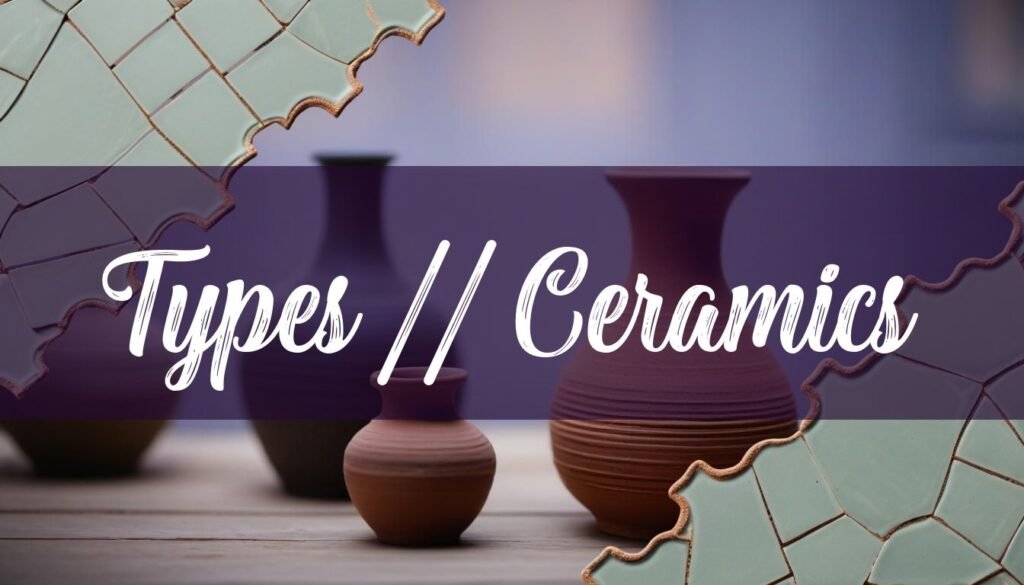Ceramics are a diverse group of materials with a wide array of applications, broadly categorized into three main types: earthenware, stoneware, and porcelain. Each type possesses unique characteristics derived from differences in composition, firing temperature, and manufacturing processes. These distinctions dictate their suitability for various uses, ranging from everyday pottery to advanced technical components. Understanding the nuances of each ceramic type is essential for appreciating their versatility and selecting the appropriate material for specific applications.
Earthenware
Earthenware is one of the oldest forms of ceramics, characterized by its relatively low firing temperature, typically below 1200°C (2192°F). This lower firing temperature results in a product that is nonvitreous and has medium to high porosity. Due to its porous nature, earthenware is often glazed to achieve fluid impermeability and provide an aesthetically pleasing finish. The composition of earthenware typically includes clay, silica, and feldspar, although the specific ratios can vary. The clay component gives the unfired product its shaping abilities and acts as a glass former during firing, while silica serves as a filler, lending strength to the body both before and during firing. Feldspar acts as a fluxing agent, lowering the melting temperatures of the mixture.
Common uses for earthenware include tableware, decorative tile ware, and various pottery items. Its accessibility and ease of production have made it a popular choice for both functional and ornamental purposes throughout history. The porosity of earthenware, while requiring glazing for liquid containment, also makes it suitable for certain horticultural applications, such as terracotta pots, where the material’s breathability can benefit plant health. However, its lower strength and durability compared to stoneware and porcelain limit its use in more demanding applications. Traditional manufacturing processes for earthenware involve shaping the clay mixture through methods like hand-building, wheel throwing, or molding, followed by air-drying and firing in a kiln. Modern techniques may incorporate automated processes for shaping and glazing, but the fundamental principles remain largely unchanged. For those interested in glazing techniques, exploring glazing techniques for potters can enhance the aesthetic and functional qualities of earthenware. Additionally, understanding the use of the best paint to use on ceramic is crucial for achieving the desired finish on earthenware items.
Despite its limitations, earthenware continues to be valued for its rustic charm, affordability, and versatility in decorative applications. Its vibrant colors and textures, often achieved through various glazing techniques, make it a favorite among artists and craftspeople. While it may not possess the strength or durability of other ceramic types, earthenware’s rich history and enduring appeal ensure its continued presence in both traditional and contemporary ceramics.
Stoneware
Stoneware represents a significant step up from earthenware in terms of durability and functionality. It is a semivitreous or vitreous whiteware characterized by a fine microstructure. Stoneware is fired at higher temperatures, typically between 1200°C and 1300°C (2192°F and 2372°F), which causes the clay particles to partially or fully vitrify, resulting in a denser, less porous material. This vitrification process enhances its strength, water resistance, and overall durability, making it suitable for a wider range of applications. Like earthenware, stoneware bodies typically consist of clay, silica, and feldspar, but the proportions and types of clay used can vary to achieve specific properties.
Due to its enhanced properties, stoneware is commonly used for tableware, cookware, chemical ware, and sanitary ware such as drainpipes. Its ability to withstand high temperatures and resist chemical corrosion makes it an ideal choice for functional items that are exposed to harsh conditions. Stoneware tableware, for example, is often preferred for its durability and resistance to chipping or cracking, while stoneware cookware can withstand the rigors of oven and stovetop use. The manufacturing process for stoneware typically involves shaping the clay mixture through methods like wheel throwing, molding, or slip casting. After shaping, the ware is dried and then fired in a kiln at the appropriate temperature to achieve vitrification. Glazes are often applied to stoneware to enhance its appearance and provide a waterproof surface.
The development of stoneware marked a significant advancement in ceramic technology, allowing for the creation of more durable and functional items.
Its versatility and robustness have made it a staple in both domestic and industrial applications, and it continues to be a popular choice for potters and manufacturers alike. The combination of strength, durability, and aesthetic appeal ensures that stoneware remains a valuable and widely used ceramic material.
Porcelain
Porcelain stands at the pinnacle of ceramic development, renowned for its exceptional strength, translucence, and elegance. It is a vitreous whiteware fired at very high temperatures, typically between 1200°C and 1400°C (2192°F and 2552°F), resulting in a completely vitrified, nonporous body. Porcelain is distinguished by its fine particle size and high proportion of kaolin, a pure white clay, which contributes to its characteristic translucence and whiteness. The composition also includes silica and feldspar, carefully balanced to achieve the desired properties.
Porcelain is primarily used in fine china, electrical insulators, and technical applications. Its delicate appearance and smooth surface make it a prized material for tableware and decorative objects, while its excellent electrical insulation properties make it essential for high-voltage applications. In technical applications, porcelain is used in chemical ware, dental implants, and various components requiring high strength and chemical resistance. The manufacturing process for porcelain is more complex and demanding than that of earthenware or stoneware. It often involves shaping the clay mixture through methods like slip casting, pressing, or molding, followed by meticulous drying and firing in a carefully controlled atmosphere. Multiple firings may be required to achieve the desired translucence and glaze effects.
The creation of porcelain represents a triumph of ceramic technology, pushing the boundaries of material science and artistic expression. Its beauty, strength, and versatility have made it a symbol of luxury and refinement, while its technical properties have enabled its use in critical industrial applications. Despite its higher cost and more complex manufacturing process, porcelain remains a highly valued and widely used ceramic material, prized for its unique combination of aesthetic and functional attributes.





